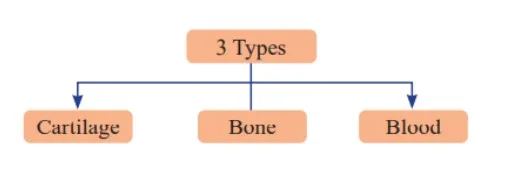
Tissues: A tissue is a collection of cells with similar structural and functional properties. Tissues are the intermediate level of organization between cells and organ systems. The integration of different types of tissues forms organs. Biological organisms have the following hierarchical organization:
Cells ➡️ Tissues ➡️ Organs ➡️ Organ Systems ➡️ Organisms
Tissues in animals are collections of cells that work together to carry out specific functions. Animal tissues are classified into four types, each with a distinct structure and function: epithelial tissues, muscular tissues, connective tissues, and nervous tissues. Each tissue type has its own role in the structure and function of the body. The article provided information about the tissues of the human body, types, and other aspects of the structural organisation in animals chapter from class 11.
What are Animal Tissues?
Animal tissues are specialized tissues only found in animals, not plants or other organisms. Animals have a wide range of organs, including skin, eyes, the heart, and many others, each composed of tissues that perform specific functions. Animal cells have aggregated together to form these tissues. The structure, function, and development of animal tissues differ significantly. Animal tissues are classified into four types: epithelial, connective, muscular, and nervous tissues of human body.
Structural Organisation in Animals MCQ
Types of Animal Tissues
There are four types of animal tissues: epithelial, connective, muscular, and nervous. Organs form when tissues come together to perform specific functions. The layers of cells that cover the body's external surfaces, line internal cavities and passageways, and form particular glands are called epithelial tissue, or epithelium. Connective tissue connects cells and organs, offering support, protection, and integration throughout the body.
Muscle tissue is capable of excitability, responding to stimulation and contracting to enable movement. It exists in three main forms: skeletal (voluntary), smooth, and cardiac muscle found in the heart. Nervous tissue, which is also excitable, facilitates the transmission of electrochemical signals as nerve impulses, allowing communication between various body regions.
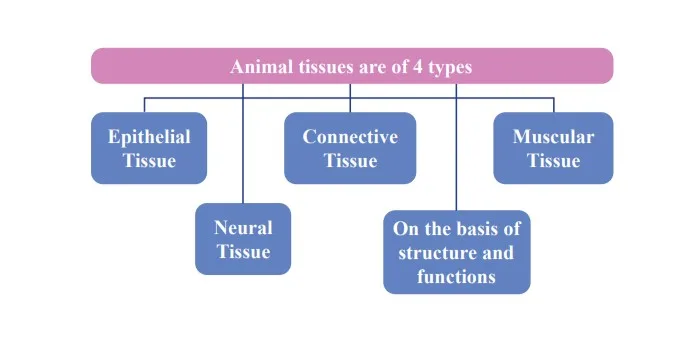
Epithelial Tissues
Epithelial tissue is a type of animal tissue that covers and protects various organs and body cavities. It serves as a barrier, controlling the flow of materials between the body and its surroundings and dividing various bodily systems from one another. Animal tissue known as epithelial tissue coats and shields the surfaces of internal organs and bodily cavities.
Function: It acts as a barrier, separating different body systems and regulating the exchange of materials between the body and the external environment.
Location: Epithelial tissue is found in various parts of the body, including:
- Skin
- Mouth lining
- Blood vessels
- Lung alveoli
- Kidney tubules
Cell Structure: Cells in epithelial tissue are tightly packed and form a continuous sheet with very little space between them.
Types of Epithelial Tissue
The Types of epithelial tissues are as follows:
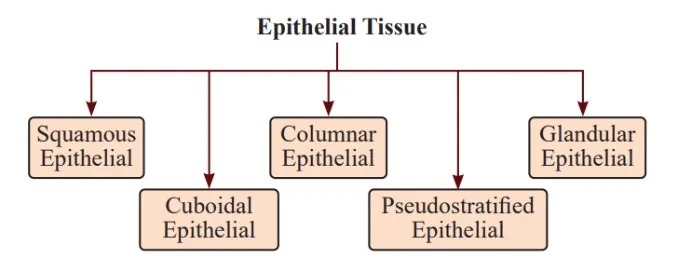
Simple Epithelium: It is made up of one layer of cells. Lines ducts, tubes, and cavities in the body.
Simple Squamous Epithelium: Thin and flat cells found in areas where substances need to pass through easily, like the lining of blood vessels.
Stratified Squamous Epithelium: Multiple layers of cells providing protection against wear and tear, found in the skin and the lining of the mouth.
Columnar Epithelium: Tall and pillar-like cells found in areas where absorption and secretion occur, such as the inner lining of the intestine.
Ciliated Columnar Epithelium: Cells with cilia (hair-like projections) on the surface, found in the respiratory tract to help move mucus.
Cuboidal Epithelium: Cube-shaped cells lining the kidney tubules and salivary gland ducts, providing support.
Glandular Epithelium: Epithelial tissue can also form glandular epithelium, where cells secrete substances. Glands can be classified based on their structure and function, such as sweat glands and salivary glands.
Compound epithelium: A tissue composed of multiple layers of cells. It has a limited role in secretion and absorption, but its primary function is to protect against chemical and mechanical stress. This type of epithelium covers both dry and moist surfaces, including the buccal cavity, pharynx, and the inner linings of salivary gland and pancreatic ducts.
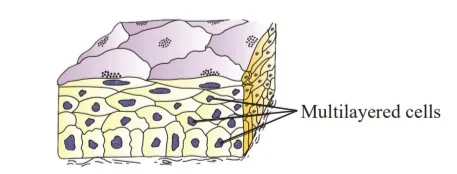
Connective Tissues
Connective tissues are a vital part of our bodies, made up of both living cells and nonliving material called extracellular matrix. They play a crucial role in connecting and supporting different organs and tissues. Here's a simplified breakdown:
Composition: Connective tissues contain more extracellular material than living cells. The cells are embedded within this material, which forms the structure of the tissue.
Function: Connective tissues connect different cells and tissues in the body. They also provide support and protection to soft tissues, help transmit mechanical forces, and produce certain carbohydrates and proteins.
Types of Connective Tissues
Below are the different kinds of connective tissues:
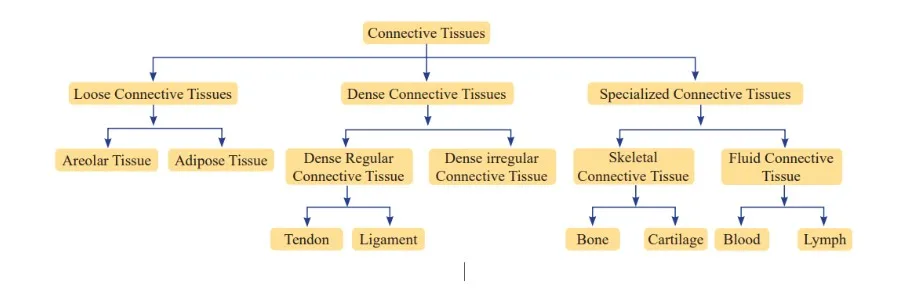
- Dense Connective Tissue: This type has more fibers than ground substance.

- Dense Regular Connective Tissue: Found in tendons and ligaments, it has collagen fibers arranged in a parallel manner, providing strength.
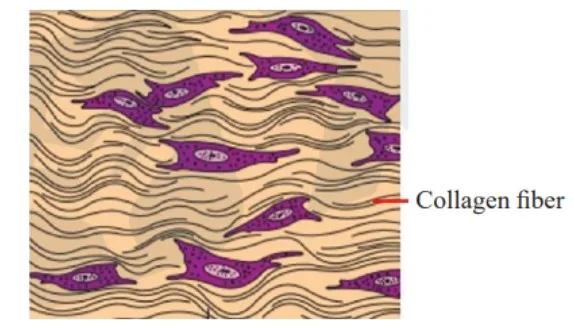
- Dense Irregular Connective Tissue: Found in the skin's lower layers (dermis) and the eyeball's protective layer, it has collagen fibers arranged in multiple directions, providing flexibility and strength.
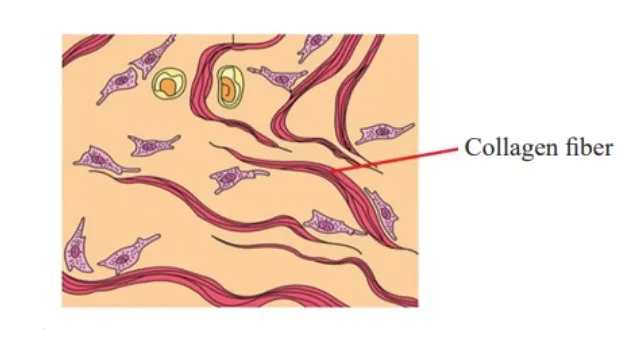
Loose Connective Tissue: This type has more ground substance than fibers, giving it a more flexible structure. There are two types of Loose connective tissues: 
Special connective Tissue: Includes various types such as adipose tissue (fat), cartilage, bone, and blood, each serving specific functions in the body.
These tissues are essential for the body's structure and function, helping to maintain its overall health and well-being.
Muscle Tissues
Muscle cells, or myocytes, are the building blocks of muscle tissue in our bodies. They are responsible for making our bodies move by contracting and relaxing.
Types of Muscle Tissues
There are three main types of muscle tissue:
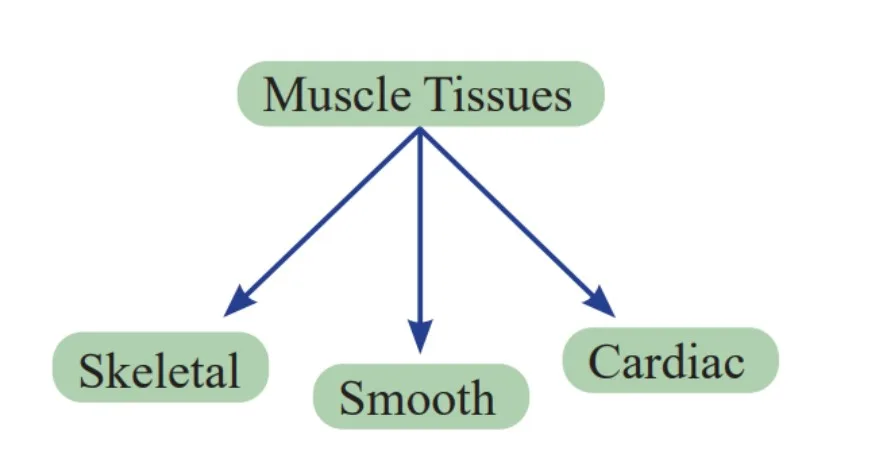
1. Smooth Muscle: This type of muscle is found in the walls of internal organs like the stomach, intestines, and blood vessels. It helps these organs contract and relax to move substances through the body.
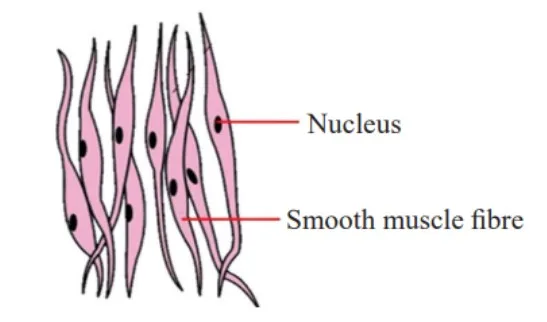 2. Skeletal Muscle: Skeletal muscles are attached to our bones and help us move our body parts, like arms and legs. They also help us maintain posture and stay upright.
2. Skeletal Muscle: Skeletal muscles are attached to our bones and help us move our body parts, like arms and legs. They also help us maintain posture and stay upright.
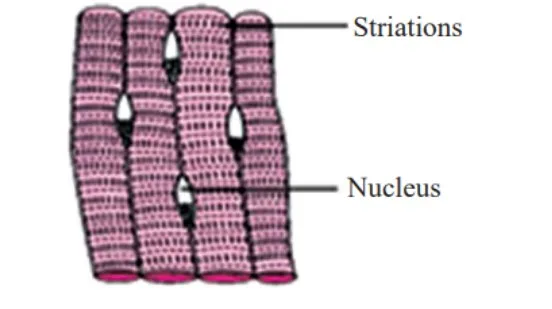 3. Cardiac Muscle: Cardiac muscle is found only in the heart. It contracts to pump blood around the body and keep us alive.
3. Cardiac Muscle: Cardiac muscle is found only in the heart. It contracts to pump blood around the body and keep us alive. 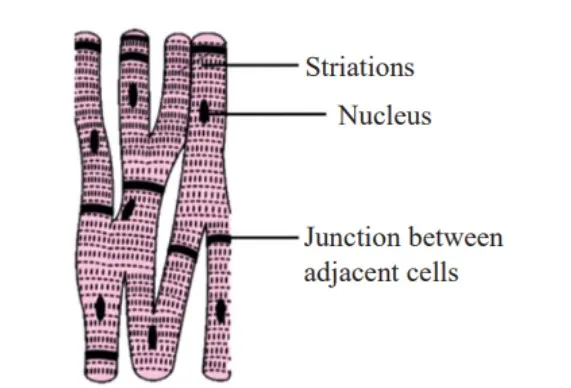
Muscle tissue plays several important roles in the body:It helps us maintain an upright posture.
- It allows us to move voluntarily, like when we walk or run.
- It also helps with involuntary movements, like the beating of our heart and the movement of food through our digestive system.
- Muscle tissue is also important for pumping blood and regulating blood flow in our arteries.
- It helps us breathe by controlling the movement of air in and out of our lungs.
Neural Tissues
Nervous tissue is a key component of our body's communication system, consisting of two main parts: the peripheral nervous system (PNS) and the central nervous system (CNS).
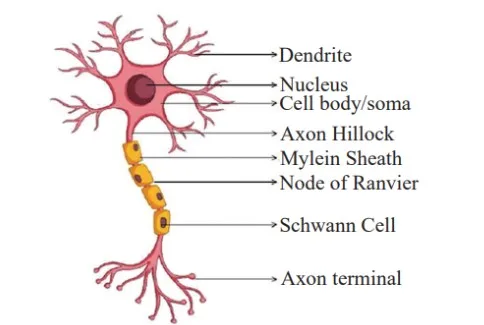
Types of Neural Tissues
Below are the types of neural tissues:
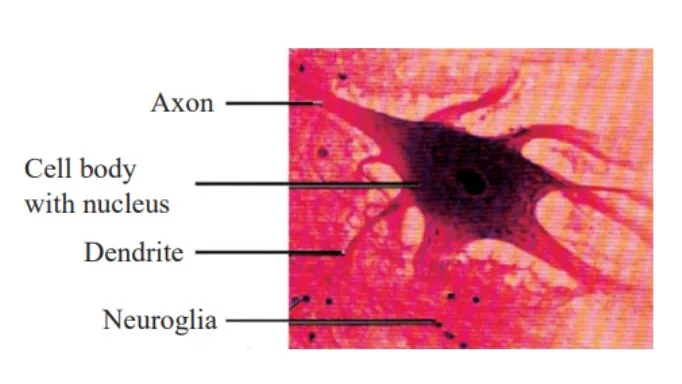
- Central Nervous System (CNS): This part includes the brain and spinal cord. It is responsible for processing information and coordinating the body's responses.
- Peripheral Nervous System (PNS): The PNS consists of sensory, motor, and autonomic nerves. Control and communication between the central nervous system (CNS) and the rest of the body are made possible by these nerves.
Nervous tissue is made up of specialised cells called neurons. Neurons have a long body and branches called dendrites and axons. Dendrites receive signals from other neurons, while axons transmit signals away from the cell body.
In the CNS, neurons form complex networks that process information. In the PNS, they relay information between the CNS and the rest of the body.
Nervous tissue works by transmitting electrical signals called nerve impulses. These impulses travel along the axons of neurons and are transmitted to other neurons or muscle cells through chemical messengers called neurotransmitters.
Overall, nervous tissue plays a crucial role in controlling our body's functions and responses to the environment, allowing us to move, think, and feel.
Physics Wallah NEET Online Coaching in India is the most effective way to prepare for the NEET Exam Examination. PW provides a wide range of NEET coaching courses, including free NEET online coaching in multiple languages for Class 11 students. PW is well-known for its diverse courses, recorded and live classes, affordable tuition, experienced faculty, question-and-answer sessions, and study materials, all of which contribute to an excellent learning experience.
| NEET Exam Important Links | |
|---|---|
| NEET Biology Syllabus | NEET Biology Diagrams |
| NEET Biology MCQ | NEET Biology Chapter wise Weightage |
| NEET Exam Notes | NEET Previous Year Question papers |
Tissues FAQs
What are the 4 types of tissues?
What is the function of tissue?
What is body tissue?
What are permanent tissues?
What is a tissue in biology?
Who discovered tissue?

